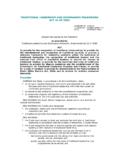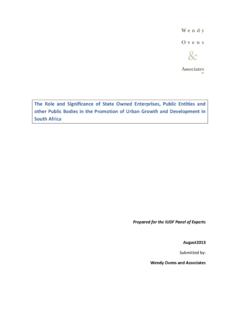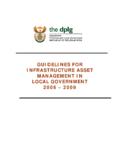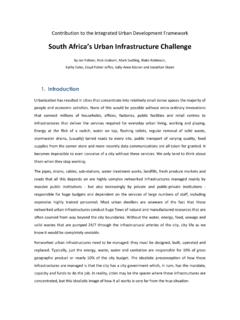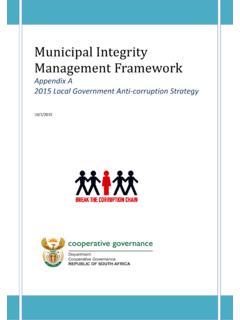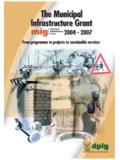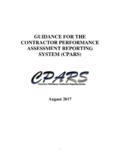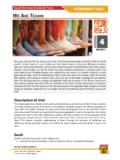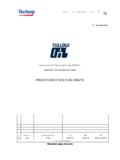Transcription of Project Monitoring and Reporting
1 Project Monitoring AND Reporting . Purpose To provide increased Project visibility through efficient and effective Project Monitoring and Reporting . Overview Project Monitoring and Reporting involves: ?? The Monitoring of actual Project progress as compared to the planned Project progress and the collection of key progress metrics such as risks, issues, changes and dependencies; and ?? The Reporting of Project status, costs and outputs and other relevant information, at a summary level, to the Project sponsor, Project steering committee and other Project stakeholders.
2 Project Monitoring typically involves tracking five variables: ?? Schedule - the estimated effort and duration versus the actual effort and duration;. ?? Costs - the estimated cost versus the actual costs;. ?? Deliverables - what products or components have been delivered and plan to be delivered;. ?? Quality - how well are the deliverables being completed; and ?? Benefits - are the processes in place to achieve and to measure the lead indicators for benefits realisation. The format and timing of Project Monitoring and Reporting will vary in each organisation and will also depend upon such items as the size, duration, risk and complexity of the Project .
3 Project Reporting Frequency and Project Size For small projects, there is normally only a Project Sponsor and because small projects are generally less than three months in duration, a Project review with the sponsor should occur either weekly or two-weekly. For medium projects, there would normally be a steering committee and meetings would normally be held monthly. For larger projects, there may be a Project steering committee at executive level as well as other specialist steering committees such as an IT steering committee, so meetings might be monthly or quarterly.
4 High-risk projects are subject to more change and turbulence and, as a result, the Project Reporting and review process may be more frequent and be demand driven. In large, high-risk projects, the steering committee may delegate the demand-driven Reporting role to the Project Sponsor or a sub-committee, as it often is too difficult to convene the steering committee at short notice. Sample reports have been included in a large number of the Execution Stage Phases. If the reports to be used as part of Project Monitoring and Reporting have not been selected as part of the Project Office tailoring, they should be selected now.
5 The roles and responsibilities for the Project Monitoring and Reporting are defined. This phase should be considered in conjunction with the Planning and Scheduling phase as the two phases are closely linked. Page 1. Summary Inputs Project Information Project Organisation Chart Business Case Issues Project Plans Risk Log Tasks Define Project Monitoring Process, Roles and Responsibilities Define Project Reporting Process, Roles and Responsibilities Monitor Progress and Prepare Reports Interim work products Phase deliverables Project Monitoring Approach Project Monitoring Roles and Responsibilities Project Reporting Approach Project Reporting Roles and Responsibilities Project Reports Reference materials Project Monitoring and Reporting Task/Responsibility Matrix Project Reporting Matrix Sample Detailed Reports Sample Summary Reports Page 2.
6 Project Monitoring and Reporting Project Information Project Define Project Monitoring Project Monitoring Process, Roles and Approach Organisation Chart Project Monitoring Roles Business Case Responsibilities and Responsibilities Define Project Reporting Project Reporting Approach Process, Roles and Project Reporting Roles Responsibilities and Responsibilities Monitor Progress and Prepare Reports Project Reports Page 3. 1 Define and Implement Project Monitoring Process, Roles and Responsibilities Purpose To define the Project Monitoring process, to define the Project Monitoring roles and responsibilities and to implement and operate the process.
7 Overview This task addresses the techniques and approaches to be used to monitor the Project throughout its life cycle and the tracking of the five main Project variables - schedule, costs, deliverables, quality and benefits. There are a number of different techniques which can be used to monitor projects and two are suggested and discussed: ?? Critical Path Analysis which is defined as a series or path of activities that defines the longest path through the Project and therefore establishes the minimum duration of the Project .
8 It includes a path of activities with float less than or equal to zero. ?? Variance Analysis which is defined as any deviation of Project work from what was planned in schedule, costs, deliverables, quality and benefits. Other techniques which may be used include the Program Evaluation and Review Technique (PERT). This is an event and probability based network analysis technique generally used in the research and development field where activities and durations between events are difficult to define at the planning stage, yet completion of these activities by specific dates is essential to the success of the Project .
9 Typically these projects involve large programmes, large organisations and extensive operations in many different locations. The roles and responsibilities for each of the Project Monitoring tasks are defined. Determine the organisation's current Project Monitoring processes, roles and responsibilities and systems. Determine the organisation's current Project Monitoring process, roles and responsibilities and systems. Determine whether any of these existing activities need to be included as part of the Project Monitoring approach.
10 Define the approach to be used to monitor the Project schedule. A Project schedule consists of all of the activities and tasks designed to achieve the specific goals of the Project , as defined by the Project scope, whilst staying within the budget and optimising the use of resources. Whilst an experienced Project Manager may have a certain intuition for progress slippage or may detect it in discussions with deliverable owners, there are also formal techniques which can be used to monitor the Project schedule, two of which, Critical Path and Variance Analysis, are described below.

![Disaster Management Act [No. 57 of 2002]](/cache/preview/e/5/d/2/b/3/6/7/thumb-e5d2b36743b64ebe9204d7e874f734ad.jpg)
